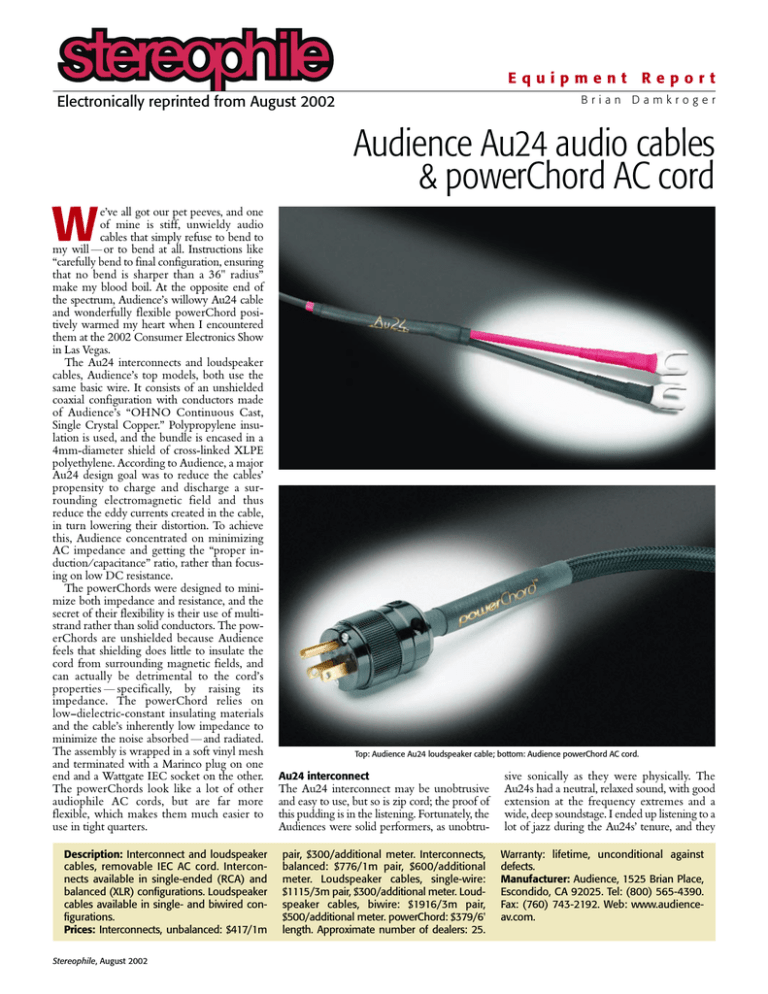
Equipment Report
Brian Damkroger
Electronically reprinted from August 2002
Audience Au24 audio cables
& powerChord AC cord
W
e’ve all got our pet peeves, and one
of mine is stiff, unwieldy audio
cables that simply refuse to bend to
my will — or to bend at all. Instructions like
“carefully bend to final configuration, ensuring
that no bend is sharper than a 36" radius”
make my blood boil. At the opposite end of
the spectrum, Audience’s willowy Au24 cable
and wonderfully flexible powerChord positively warmed my heart when I encountered
them at the 2002 Consumer Electronics Show
in Las Vegas.
The Au24 interconnects and loudspeaker
cables, Audience’s top models, both use the
same basic wire. It consists of an unshielded
coaxial configuration with conductors made
of Audience’s “OHNO Continuous Cast,
Single Crystal Copper.” Polypropylene insulation is used, and the bundle is encased in a
4mm-diameter shield of cross-linked XLPE
polyethylene. According to Audience, a major
Au24 design goal was to reduce the cables’
propensity to charge and discharge a surrounding electromagnetic field and thus
reduce the eddy currents created in the cable,
in turn lowering their distortion. To achieve
this, Audience concentrated on minimizing
AC impedance and getting the “proper induction/capacitance” ratio, rather than focusing on low DC resistance.
The powerChords were designed to minimize both impedance and resistance, and the
secret of their flexibility is their use of multistrand rather than solid conductors. The powerChords are unshielded because Audience
feels that shielding does little to insulate the
cord from surrounding magnetic fields, and
can actually be detrimental to the cord’s
properties — specifically, by raising its
impedance. The powerChord relies on
low–dielectric-constant insulating materials
and the cable’s inherently low impedance to
minimize the noise absorbed — and radiated.
The assembly is wrapped in a soft vinyl mesh
and terminated with a Marinco plug on one
end and a Wattgate IEC socket on the other.
The powerChords look like a lot of other
audiophile AC cords, but are far more
flexible, which makes them much easier to
use in tight quarters.
Description: Interconnect and loudspeaker
cables, removable IEC AC cord. Interconnects available in single-ended (RCA) and
balanced (XLR) configurations. Loudspeaker
cables available in single- and biwired configurations.
Prices: Interconnects, unbalanced: $417/1m
Stereophile, August 2002
Top: Audience Au24 loudspeaker cable; bottom: Audience powerChord AC cord.
Au24 interconnect
The Au24 interconnect may be unobtrusive
and easy to use, but so is zip cord; the proof of
this pudding is in the listening. Fortunately, the
Audiences were solid performers, as unobtrupair, $300/additional meter. Interconnects,
balanced: $776/1m pair, $600/additional
meter. Loudspeaker cables, single-wire:
$1115/3m pair, $300/additional meter. Loudspeaker cables, biwire: $1916/3m pair,
$500/additional meter. powerChord: $379/6'
length. Approximate number of dealers: 25.
sive sonically as they were physically. The
Au24s had a neutral, relaxed sound, with good
extension at the frequency extremes and a
wide, deep soundstage. I ended up listening to a
lot of jazz during the Au24s’ tenure, and they
Warranty: lifetime, unconditional against
defects.
Manufacturer: Audience, 1525 Brian Place,
Escondido, CA 92025. Tel: (800) 565-4390.
Fax: (760) 743-2192. Web: www.audienceav.com.
proved a good match for vivid, live discs like
the JVC XRCD of the Bill Evans Trio’s At
Shelly’s Manne-Hole (JVCXR-0036-2). Evans’
piano was vibrant and three-dimensional, and
Chuck Israel’s bass was clean and articulate,
with just the right amount of bounce and a
warm, woody resonance. Larry Bunker’s drums
were sharp and crisp, and his cymbal was beautifully reproduced. The bell-like ring led and
centered its image, followed by an expanding,
shimmering halo, every nuance of his stick and
brushwork clearly inscribed in space.
The Au24 acquitted itself well in comparisons to my two reference interconnects, the
Nordost Valhalla and the Nirvana S-X Ltd., but
didn’t quite match their performance in the
areas where those wires truly excel. The Au24
was vivid, for example, but lacked the density of
tonal colors and the nth degree of inner detail
that the Valhalla produces. Nor did it quite
match the Valhalla’s incredible speed and precision — though the Au24 was no slouch itself in
those terms.
On the other hand, the Au24s were slightly
faster and more dynamic than the Nirvana S-X
Ltds., with a slightly more forward soundstage
and sharper definition of image edges. The
Au24s didn’t, however, match the Nirvanas’
continuity, or their incredibly natural soundstage reproduction and ambience retrieval.
Compared to the Au24s, the S-X Ltds. sounded
a little laid-back, but with a huge, open soundstage and a “just right” way of portraying space
and images — in particular, how the images
blended into the surrounding ambience to create a seamless, natural whole.
On “Dance of the Rose Maidens,” from the
Antal Dorati/LSO performance of Khachaturian’s Gayne ballet (Mercury Living Presence 434
323-2), a muted trumpet — way down in level
and deep in the soundstage — provides a counterpoint to the melody throughout much of the
piece. This trumpet line was more obvious —
brighter and more sharply etched — with the
Au24s. With the Nirvanas, however, it blended
more naturally into the surrounding space. And
Associated Equipment
Analog source: VPI TNT Mk.V-HR
turntable and tonearm, Grado Signature
Reference cartridge.
Digital source: Simaudio Moon Eclipse
CD player.
Preamplifier: VAC Renaissance Signature Mk.II.
Power amplifiers: VTL Ichiban
monoblocks.
Loudspeakers: Magnepan MG3.6/R.
Cables: Interconnect: Nirvana S-X
Ltd., Nordost Valhalla. Speaker: Nirvana SL, Nordost. AC: Synergistic
Research A/C Reference Master Couplers.
Accessories: Merrill equipment stand;
Bright Star Big Rock, Little Rock, and Air
Mass isolation devices; Nordost ECO3
and Disksolution CD cleaning/treatment
fluids; MIT ZCenter power-conditioning
and delivery system.
— Brian Damkroger
that space, its ambience, and the surrounding
walls — all low-level details and subtleties —
were better portrayed with the Nirvanas. The
Au24s were no slouch in this regard, just a bit
off the standard set by the very best I’ve heard.
Au24 speaker cable
The slender Au24 seems even less likely as a
speaker cable. After all, speaker cables have to
be massive to pass all that current, right? Apparently not — it was as a speaker cable that the
Au24 really shone. I spent quite a bit of time
going back and forth between the Au24 and my
reference Valhalla, and ended up preferring the
Au24.
The Au24 had a slightly warmer tonal balance — double basses and cellos were reproduced with more authority, and a more realistic
weight and resonance. Images were a bit more
dimensional with the Au24s, and slightly more
solid and dense. Part of it was a slightly better
resolution of inner detail. The xylophone at the
opening of “Dance of the Rose Maidens” was
more distinctive with the Au24s, with a slightly
woodier bite and a better sense of the instrument’s shape and configuration. Another component was the way the Au24s seemed to fill in
the images and give them solidity and mass. In
comparison, the Valhallas seemed to slightly
overemphasize image edges, like a video image
with the contrast set a smidgen too high. And
last, the Au24s produced a slightly larger and
more open soundstage, and did a better job of
resolving the spaces between images, particularly from front to back.
powerChord AC cord
I recently moved cross-country, into my fiancée
Trish’s suburban California home, and let me
tell you, the power here sucks. I’m reluctant to
pay for an electrician to install a dedicated circuit
or multiple grounds because we’re house-hunting, so I’ve been doing a lot of experimenting
with aftermarket power conditioners and AC
cords. The setup that has evolved includes
AudioPrism QuietLine filters scattered around
and an MIT ZCenter conditioner for the preamp and front-end gear. I used the Audience
powerChords to run from the ZCenter to a
VAC Renaissance Signature Mk.II preamp and
a Simaudio Moon Eclipse CD player, and to
feed my VTL Ichiban amplifiers directly from
the wall.
Each component of this treatment setup
yielded significant and similar improvements,
lowering the noise floor and removing layers of
grunge. Dynamics were cleaned up and the resolution of inner detail was noticeably improved,
making images seem more realistic and much
more dimensional. Spaces between instruments
or orchestral sections were opened up, where
before it seemed as if instruments were being
run together.
A big benefit was an improvement in how
the system reproduced the ambience of the
recording venue — the space around the muted
trumpet in “Dance of the Rose Maidens” was a
great example. Rather than being mired in a
nebulous sea of grunge, the trumpet (after AC
cleanup) was now suspended in a holographic
image of the stage rear, complete with back
wall, side walls, and overhead space.
Triangulating in on the powerChords, I
found that their biggest contributions were
opening up the soundstage, expanding it and
clearing out inter-image congestion, and dramatically improving the resolution of low-level
and inner detail. Images were more tangible
with the powerChords in the system, more lifelike and alive — even in the farthest corners of
the soundstage. With the stock power cords
installed, I could follow the low-level trombone
lines woven deep into “Dance of the Rose
Maidens.” With the powerChords, I got a sense
of the space around the trombones, and of multiple instruments playing together.
When I compared the powerChords to a few
other brands I had on hand, I found that they
were very similar in performance to my longtime fave AC cords, Synergistic Research’s AC
Master Couplers. The two brands’ contributions to cleaning up the sound were similar, and
both significantly improved detail and dimensionality. Overall, however, I preferred the Synergistics —they offered better senses of space and
of the recording venue’s ambience. That trombone section was definitely a group of individual instruments with the Synergistics; I could
begin to follow the individual instruments. On
the other hand, the powerChords were very
nearly as good, and a whole lot easier to integrate into a system, than the unwieldy A/C
Master Couplers.
Summary
The Audience Au24 and powerChord cables
are well worth checking out. They were excellent performers, reasonably priced, and, best of
all, incredibly easy to use in any system configuration. As an interconnect, their performance was well above the best bargain cables
from companies like Alpha-Core, Kimber, and
Nordost, and not too far removed from that of
the best, most outrageously priced cables I’ve
heard. And as a speaker cable, the Au24 held its
own against the very best I’ve heard — cables
that cost several times as much.
The wonderfully flexible powerChord, too,
was a winner, significantly cleaning up the
sound by lowering the noise floor, opening up
the space between instruments, and significantly
improving the system’s resolution of low-level
and inner detail.
The Audience cables are definitely recommended — unless, of course, you really do need
your cables to do double duty as chin-up bars or
s
towropes!
Manufacturers’ Comments
Audience Au24 & powerChord
Editor:
I would like to thank Brian Damkroger and Stereophile
magazine for reviewing the Audience Au24 audio
cables and powerChord. It is apparent that Mr.
Damkroger took the time to make a careful and thorough evaluation of our cables.
We have recently made significant upgrades to the
powerChord. This has resulted in audibly improved
performance from top to bottom. We are offering upgrades of older powerChords to our customers at $50
to $100, depending on vintage.
Richard A. Smith
Director of Product Development, Audience LLC
Posted with permission from the August 2002 issue of Stereophile ®
Copyright 2002, PRIMEDIA Inc. All rights reserved.
For more information about reprints from Stereophile, contact Wright’s Reprints at 877-652-5295




